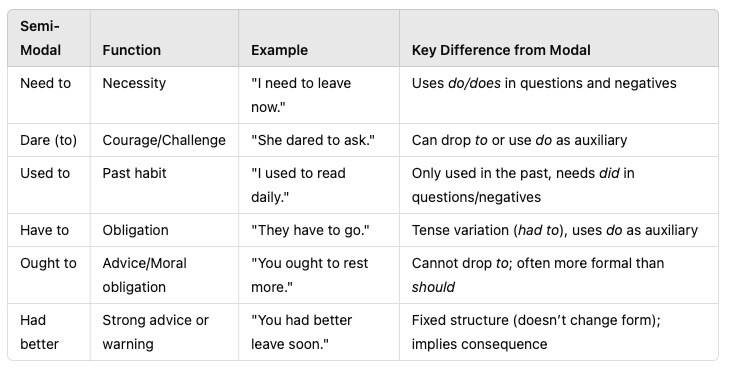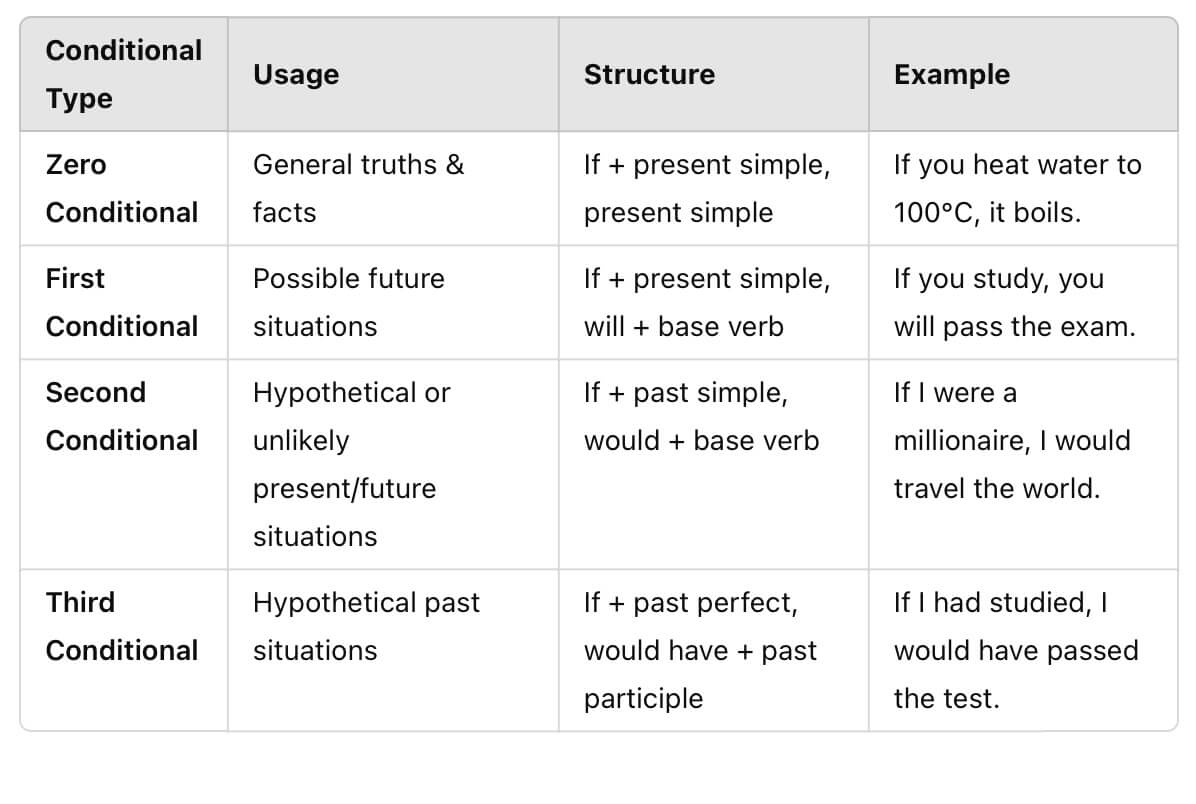- Home
- Modals in English grammar
- Semi-modal Verbs Explained
Semi-Modal Verbs Explained
Semi-modal verbs (also known as marginal modal verbs, a semi-auxiliary, or a lexical auxiliary) are a unique group of verbs that function similarly to modal verbs (e.g. can, must, or should) but do not always follow all the typical grammar rules associated with them.
Understanding semi-modals helps deepen comprehension of English’s nuances, especially in terms of expressing obligation, ability, permission, and necessity.
Let’s dive in, looking at what they are and how they compare to normal or 'pure' modal verbs!
What Are Semi-Modal Verbs?
Semi-modal verbs share some characteristics with modal verbs, such as providing additional meaning to the main verb in a sentence (e.g., expressing ability, necessity, permission).
- We need to take our time with this project and not rush it
However, they differ in that they sometimes act more like regular verbs. This means that unlike pure modals, which don’t change form or use auxiliary verbs, semi-modals can sometimes have different forms (tenses) and can use auxiliaries (like do and have).
List of Semi-Modal Verbs
The main semi-modal verbs in English are:
- Need to
- Dare (to)
- Used to
- Have to
- Ought to
- Had better
Would rather, be about to, be able to, be going to, be likely to, and be supposed to are also sometimes categorised as semi-modal verbs, but in this lesson we'll focus on the above six.
Key Differences Between Modals and Semi-Modals
We'll now look at the main semi-modal verbs and the key difference between these types of modal verbs and pure modal verbs.
- Inflection: Unlike pure modal verbs (which have no inflection), some semi-modals change to fit the tense, like have to becoming had to in the past.
- Auxiliary Use: Semi-modals can sometimes use auxiliary verbs (do, does, did), while modal verbs do not.
- Complements: Semi-modals often need to before the main verb, unlike most modals.
Comparison Table: Semi-Modals vs. Modals
Need to
This expresses necessity or requirement.
- "I need to finish this report by tomorrow." (necessity)
- "Do we need to bring our own supplies?" (question form)
Comparison with Modals:
- In its negative form, need behaves like a true modal when expressing lack of necessity: “You needn’t worry.”
- Unlike pure modals, it changes with tense: "She needed to go to the doctor" (past tense).
- Unlike must (a modal verb expressing obligation), need to can take the auxiliary verb in questions and negatives: “Do I need to attend?”
Dare (to)
Dare (to) expresses courage or a challenge. Dare can be used with or without to, but both forms work slightly differently.
- "He dared to speak against the decision." (courage)
- "How dare you question me?" (challenge, without 'to')
- "She didn’t dare to tell him the truth."
Comparison with Modals:
- In negative and question forms, dare often acts like a modal without needing an auxiliary (e.g. "we daren't speak to him").
- However, it can also act like a regular verb with auxiliaries (e.g., "Does she dare to go there? / we don't dare enter the room").
- Dare straddles both modal and non-modal verb territory because it can drop to in some constructions (e.g., “How dare you?”).
Used to
Used to is a marginal modal verb to express habitual actions or states in the past that are no longer true.
- "I used to play soccer when I was younger."
- "She didn’t use to like coffee, but now she loves it."
- "Did you use to travel a lot?"
Comparison with Modals
- Used to is always in the past; it has no present form.
- In negative and interrogative forms, did acts as an auxiliary, something true modals do not have: “Did you use to…? / I didn't used to...”
- Unlike a pure modal, used to doesn’t express permission, ability, or obligation but rather a past habit or state.
Have to
This semi-modal or marginal modal verb expresses obligation or necessity, much like must, but it behaves more like a regular verb.
- "I have to attend the meeting at 9 a.m." (present obligation)
- "She had to leave early because of an emergency." (past necessity)
- "Do we have to submit this today?"
Comparison with Modals
- Unlike pure modals and must, it changes with tense (present: have to, past: had to).
- This semi-modal verb also takes do as an auxiliary in questions and negatives.
Ought to
Ought to suggests moral obligation, advice, or the expected outcome.
- "You ought to apologise for your mistake." (moral obligation)
- "They ought to arrive soon, given the time." (expectation)
Comparison with Modals
- Like pure modals, it rarely changes form and usually remains in the present tense.
- It is similar to the modal should but more formal or stronger in tone. However, it cannot drop the to as other modals do.
Had Better
Had better is a marginal modal verb used to give strong advice or warnings. It implies that there will likely be negative consequences if the advice isn’t followed. Despite using had, it refers to the present or near future.
- "You had better finish your homework before going out." (strong advice)
In negative form, it’s usually structured as "had better not."
- "They had better not be late to the meeting." (warning)
Comparison with Modals
- Like pure modals, had better is always followed by the base form of the verb and does not vary with tense (we can't say 'have better').
- While similar in meaning to should or ought to, had better conveys a stronger sense of urgency or potential consequence.
Semi-modal Verbs Explained: Summing up
So semi-modal verbs, also called marginal modal verbs, semi-auxiliaries, or lexical auxiliaries, are a distinct group of verbs that operate similarly to modal verbs (like can, must, or should) but don’t consistently adhere to the usual grammar rules that modal verbs do.
Practice them along with pure modals and you're sure to excel in your English speaking and writing!
New! Comments
Any questions or comments about the grammar discussed on this page?
Post your comment here.









